"Intelligence is as essential to modern armies as ammunition."
- Brigadier General Joseph E. Kuhn
Stripped to its essentials, intelligence can be defined as the systematic attempt to gain advantage through secret means. It involves four types of related undertakings: collecting information, some of it secretly; conducting hidden operations, protecting the parent agency from compromise, and analyzing what has been learned. Signals intelligence, or SIGINT, was the main form of intelligence used in the second half of the 20th century.
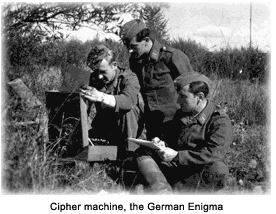 Intelligence during World War II
On the eve of World War II, the United States was the world’s only great power without an intelligence service. Many agencies collected information of one kind or another, some of it secretly, but there was no agency in charge of overall American intelligence. Great Britain had a long tradition of successful intelligence operations, and had managed to break into the highest level of German communications with the help of its skilled cryptanalysts at Bletchley Park. British predominance in the communications intelligence field in Europe continued throughout the war. The British urged President Roosevelt to create a centralized strategic intelligence organization, and although Roosevelt liked the idea, he took his time to create one. He finally signed an executive order in June 1942, which established the Office of Strategic Services (OSS) — America's first intelligence agency. The OSS was restructured as the Central Intelligence Agency (CIA), in 1947.
U.S. Army intelligence contributions were greater in the Pacific Theater during the war, but the European war exerted a large impact on the ultimate organization of army intelligence. Most of the American military resources in the field went into the fight against Germany, including the bulk of military intelligence assets.
During World War II, cryptanalysis, the science of deciphering codes, contributed significantly to the Allied victory through its contributions to the Battle of Midway and the Battle of the North Atlantic, as well as to the destruction of the Japanese merchant fleet, and to various land battles in Europe in 1944 and 1945.
Joint intelligence organizations and operations were initiated at national and theater levels during the war. Those efforts increased collection, enhanced production, and expedited distribution of critical intelligence to commanders and national policymakers. Joint intelligence efforts contributed to Allied operations in virtually every theater. Joint intelligence bloomed during 1943 and 1944 as U.S. forces transitioned from defensive to offensive operations. Island Hopping in the Pacific and Allied operations in the Mediterranean and Europe emphasized large-scale joint operations, which required joint intelligence.
World War II belligerants employed highly sophisticated ciphers. The cipher machine known as the Enigma was used to encrypt and decrypt secret messages of the highest security. The machine had been used commercially from the early 1920s, and was adopted by the military and governmental services of numerous nations, including Nazi Germany before and during World War II. It had been claimed that it would take thousands of years to crack the Enigma cipher. Building on smuggled Enigma machine components, the Enigma messages began to be deciphered by Allied codebreakers. The intelligence gained through this source, codenamed Ultra, was a significant aid to the Allied war effort. Some historians have even suggested that the end of the European part of the war was hastened by a year or more because of the decryption of German ciphers.
Cryptology was not just used in the European Theater of World War II. In the early 1930s, the Japanese Navy purchased a commercial version of the German Enigma, and modified it by adding numerous security features. The system was one of the most secure cryptographic machines in the world. "Purple" was a cipher used by Japan during the war to encode diplomatic messages to various embassies and consulates throughout the world. The United States worked to decipher the signals they intercepted from the Japanese. Once the U.S. created a "shadow machine" (a Purple machine of their own), they were soon able to decode the various messages. Those signals comprised an abundance of important information concerning Japan's plans for war and their scheduled locations of attack. As a result, the United States surprised Japan at Midway and American victory there proved to be decisive. Throughout the war, the United States staged various surprise attacks on Japan, thanks to the knowledge they had from Purple ciphers.
Intelligence during World War II
On the eve of World War II, the United States was the world’s only great power without an intelligence service. Many agencies collected information of one kind or another, some of it secretly, but there was no agency in charge of overall American intelligence. Great Britain had a long tradition of successful intelligence operations, and had managed to break into the highest level of German communications with the help of its skilled cryptanalysts at Bletchley Park. British predominance in the communications intelligence field in Europe continued throughout the war. The British urged President Roosevelt to create a centralized strategic intelligence organization, and although Roosevelt liked the idea, he took his time to create one. He finally signed an executive order in June 1942, which established the Office of Strategic Services (OSS) — America's first intelligence agency. The OSS was restructured as the Central Intelligence Agency (CIA), in 1947.
U.S. Army intelligence contributions were greater in the Pacific Theater during the war, but the European war exerted a large impact on the ultimate organization of army intelligence. Most of the American military resources in the field went into the fight against Germany, including the bulk of military intelligence assets.
During World War II, cryptanalysis, the science of deciphering codes, contributed significantly to the Allied victory through its contributions to the Battle of Midway and the Battle of the North Atlantic, as well as to the destruction of the Japanese merchant fleet, and to various land battles in Europe in 1944 and 1945.
Joint intelligence organizations and operations were initiated at national and theater levels during the war. Those efforts increased collection, enhanced production, and expedited distribution of critical intelligence to commanders and national policymakers. Joint intelligence efforts contributed to Allied operations in virtually every theater. Joint intelligence bloomed during 1943 and 1944 as U.S. forces transitioned from defensive to offensive operations. Island Hopping in the Pacific and Allied operations in the Mediterranean and Europe emphasized large-scale joint operations, which required joint intelligence.
World War II belligerants employed highly sophisticated ciphers. The cipher machine known as the Enigma was used to encrypt and decrypt secret messages of the highest security. The machine had been used commercially from the early 1920s, and was adopted by the military and governmental services of numerous nations, including Nazi Germany before and during World War II. It had been claimed that it would take thousands of years to crack the Enigma cipher. Building on smuggled Enigma machine components, the Enigma messages began to be deciphered by Allied codebreakers. The intelligence gained through this source, codenamed Ultra, was a significant aid to the Allied war effort. Some historians have even suggested that the end of the European part of the war was hastened by a year or more because of the decryption of German ciphers.
Cryptology was not just used in the European Theater of World War II. In the early 1930s, the Japanese Navy purchased a commercial version of the German Enigma, and modified it by adding numerous security features. The system was one of the most secure cryptographic machines in the world. "Purple" was a cipher used by Japan during the war to encode diplomatic messages to various embassies and consulates throughout the world. The United States worked to decipher the signals they intercepted from the Japanese. Once the U.S. created a "shadow machine" (a Purple machine of their own), they were soon able to decode the various messages. Those signals comprised an abundance of important information concerning Japan's plans for war and their scheduled locations of attack. As a result, the United States surprised Japan at Midway and American victory there proved to be decisive. Throughout the war, the United States staged various surprise attacks on Japan, thanks to the knowledge they had from Purple ciphers.
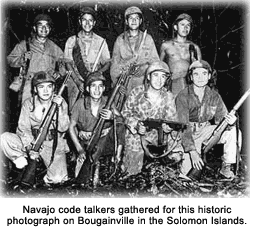 The idea to use Navajo Indians for secure communications arose in the early stages of World War II. Philip Johnston, the son of a missionary to the Navajos and one of the few non-Navajos who spoke their language fluently, was a World War I veteran who knew of the military's search for a code that would withstand all attempts at decipherment. He also knew that Native American languages had been used in World War I to encode messages. Navajo is an unwritten language of extreme complexity. It is virtually unintelligible to anyone without extensive exposure and training. The language has no alphabet or symbols, and is spoken only on the Navajo lands of the American Southwest. Navajo code talkers took part in every assault the U.S. Marines conducted in the Pacific, from 1942 to 1945.
Intelligence during the Korean War
The U.S. Signal intelligence world after World War II was one of exiting personnel and budget cuts. At the end of the war, a large number of United States military personnel desired to return to civilian life. As a result, Congress drastically reduced the size of the U.S. armed forces over the next few years. The army dropped from more than 12 million men and women in August 1945 to approximately one million by July 1947. All SIGINT operations suffered from a loss of personnel. In addition, a large number of personnel left cryptology at the end of World War II. There were also drastic budget cuts. From 1945 until the start of the Korean War, President Harry S. Truman slashed the U.S. military budget to help to pay off the deficit caused by the war, and to finance foreign aid.
The idea to use Navajo Indians for secure communications arose in the early stages of World War II. Philip Johnston, the son of a missionary to the Navajos and one of the few non-Navajos who spoke their language fluently, was a World War I veteran who knew of the military's search for a code that would withstand all attempts at decipherment. He also knew that Native American languages had been used in World War I to encode messages. Navajo is an unwritten language of extreme complexity. It is virtually unintelligible to anyone without extensive exposure and training. The language has no alphabet or symbols, and is spoken only on the Navajo lands of the American Southwest. Navajo code talkers took part in every assault the U.S. Marines conducted in the Pacific, from 1942 to 1945.
Intelligence during the Korean War
The U.S. Signal intelligence world after World War II was one of exiting personnel and budget cuts. At the end of the war, a large number of United States military personnel desired to return to civilian life. As a result, Congress drastically reduced the size of the U.S. armed forces over the next few years. The army dropped from more than 12 million men and women in August 1945 to approximately one million by July 1947. All SIGINT operations suffered from a loss of personnel. In addition, a large number of personnel left cryptology at the end of World War II. There were also drastic budget cuts. From 1945 until the start of the Korean War, President Harry S. Truman slashed the U.S. military budget to help to pay off the deficit caused by the war, and to finance foreign aid.
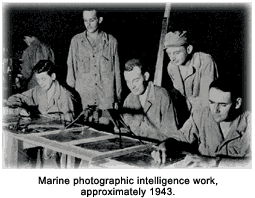 In the five years before the start of the Korean War, the focus of the United States SIGINT was on Soviet and Communist Chinese problems. That was due to increased tensions of the Cold War and the fall of China to the Communists. Adequate resources were given to provide for those problems, while apparently such secondary concerns as North Korea were given less attention. The Korean War was the first armed confrontation of the Cold War. It also expanded the Cold War, which, to that point, had been mostly concentrated in Europe.
Collection of North Korean signals started inadvertently in April 1949 when a U.S. Army intercept station began to gather them. However, dedicated North Korean collection was not initiated until April 1950. Approximately 200 messages were collected before the war had even begun.
Communications intelligence was hampered by supply shortages, as well as gear and equipment that was not appropriate for frequent movement over rough terrain. During the war, a new communications intelligence tool was discovered and implemented. It was observed that detection devices planted near enemy bunkers were capable of intercepting telephone calls. Chinese and Korean telephone traffic was collected, and became known as "ground-return intercept."
The war ended in August 1953, after more than three years of combat, with the signing of a truce and the exchange of prisoners. During the war and in postwar investigations, there were many charges that U.S. intelligence had faltered in the Korean War, by failing to give warnings of the initial North Korean attack in June 1950, and again when the Chinese entered the war in October 1950. Unlike the result in World War II, Allied forces did not achieve a military victory in Korea, but ended up at a negotiating table.
Intelligence during the Cold War
It may be said that the Cold War, or Bloodless War, began sometime during the eight weeks between the formal surrender of the German armies on May 8, 1945, which ended the first phase of World War II, and July 4, 1945, when the Soviet military authorities first allowed American organizations to set up shop in Berlin. It was called the Cold War because it did not actually lead to any direct fighting on a large scale.
With the exception of border skirmishes, the armies of the countries involved in the Cold War rarely clashed. The war was primarily fought by intelligence agencies, including the CIA (United States), MI6 (United Kingdom), BND (West Germany), Stasi (East Germany), and the KGB (Soviet Union). At the height of the Cold War, there were as many as 80 different intelligence organizations operating more or less independently in Berlin. The principal adversaries were the Americans, Russian, and East and West Germans. Each was represented by various police, intelligence, and investigative organizations.
Spies were used during the Cold War, but did not effect many events during those years. However, mutual espionage of both civilian and military targets caused the most casualties of the Cold War, since once they were detected, most spies were executed immediately.
The Cold War dominated U.S. and Soviet foreign policy for 44 years, from 1947-1991. The end of the war came on December 26, 1991, when the USSR was officially disbanded, breaking up into 15 constituent parts.
Intelligence during the Cuban Missile Crisis
The Cuban Missile Crisis of October 1962 was one of the turning points of the Cold War between the United States and the Soviet Union. The crisis had all the warnings signs of escalating into World War III — possibly a nuclear one.
The events of the Cuban Missile Crisis demonstrated the maturity of the U.S. intelligence community, especially its ability to collect and analyze information. The critical roles of human intelligence (HUMINT) and photographic intelligence (PHOTINT) in the Cuban Missile Crisis have been known from the beginning. However, recently declassified documents reveal that signals intelligence (SIGINT) also played a major role in handling the crisis.
In the five years before the start of the Korean War, the focus of the United States SIGINT was on Soviet and Communist Chinese problems. That was due to increased tensions of the Cold War and the fall of China to the Communists. Adequate resources were given to provide for those problems, while apparently such secondary concerns as North Korea were given less attention. The Korean War was the first armed confrontation of the Cold War. It also expanded the Cold War, which, to that point, had been mostly concentrated in Europe.
Collection of North Korean signals started inadvertently in April 1949 when a U.S. Army intercept station began to gather them. However, dedicated North Korean collection was not initiated until April 1950. Approximately 200 messages were collected before the war had even begun.
Communications intelligence was hampered by supply shortages, as well as gear and equipment that was not appropriate for frequent movement over rough terrain. During the war, a new communications intelligence tool was discovered and implemented. It was observed that detection devices planted near enemy bunkers were capable of intercepting telephone calls. Chinese and Korean telephone traffic was collected, and became known as "ground-return intercept."
The war ended in August 1953, after more than three years of combat, with the signing of a truce and the exchange of prisoners. During the war and in postwar investigations, there were many charges that U.S. intelligence had faltered in the Korean War, by failing to give warnings of the initial North Korean attack in June 1950, and again when the Chinese entered the war in October 1950. Unlike the result in World War II, Allied forces did not achieve a military victory in Korea, but ended up at a negotiating table.
Intelligence during the Cold War
It may be said that the Cold War, or Bloodless War, began sometime during the eight weeks between the formal surrender of the German armies on May 8, 1945, which ended the first phase of World War II, and July 4, 1945, when the Soviet military authorities first allowed American organizations to set up shop in Berlin. It was called the Cold War because it did not actually lead to any direct fighting on a large scale.
With the exception of border skirmishes, the armies of the countries involved in the Cold War rarely clashed. The war was primarily fought by intelligence agencies, including the CIA (United States), MI6 (United Kingdom), BND (West Germany), Stasi (East Germany), and the KGB (Soviet Union). At the height of the Cold War, there were as many as 80 different intelligence organizations operating more or less independently in Berlin. The principal adversaries were the Americans, Russian, and East and West Germans. Each was represented by various police, intelligence, and investigative organizations.
Spies were used during the Cold War, but did not effect many events during those years. However, mutual espionage of both civilian and military targets caused the most casualties of the Cold War, since once they were detected, most spies were executed immediately.
The Cold War dominated U.S. and Soviet foreign policy for 44 years, from 1947-1991. The end of the war came on December 26, 1991, when the USSR was officially disbanded, breaking up into 15 constituent parts.
Intelligence during the Cuban Missile Crisis
The Cuban Missile Crisis of October 1962 was one of the turning points of the Cold War between the United States and the Soviet Union. The crisis had all the warnings signs of escalating into World War III — possibly a nuclear one.
The events of the Cuban Missile Crisis demonstrated the maturity of the U.S. intelligence community, especially its ability to collect and analyze information. The critical roles of human intelligence (HUMINT) and photographic intelligence (PHOTINT) in the Cuban Missile Crisis have been known from the beginning. However, recently declassified documents reveal that signals intelligence (SIGINT) also played a major role in handling the crisis.
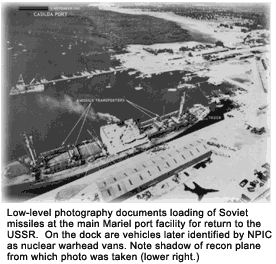 When Fidel Castro took power in Cuba by overthrowing the dictator Fulgencio Batista y Zaldívar, he was hailed as a liberator by the Cuban people and became a hero to the American people as well. Castro soon took actions that conflicted with American interests and publicly aligned his country with the Soviet Union. In Havana, one of the consequences of its alignment with the USSR was the fear that the United States might intervene against the new Cuban government. That concern eventually materialized in late 1961, when Cuban exiles, trained by America's CIA, staged a botched invasion of Cuban territory at the Bay of Pigs.
The signing of agreements with the Soviet Union was followed by a secret arms buildup in Cuba, sponsored by the Soviets and their satellites. Early indications of that buildup came from signals intelligence. The Americans became suspicious when intercept operators began to hear Spanish along with the usual mix of Slavic coming from airfields in Czechoslovakia where Cuban pilots were being trained. In response to the potential threat and the Kennedy administration's interest in it, the U.S. intelligence community began a new focus on information about Cuba. The moment of maximum danger probably came in the first two or three days of the crisis, which began with the U.S. discovery of unmistakable evidence that the Soviet Union was building launch facilities in western Cuba for ballistic missiles carrying nuclear warheads. The CIA had produced detailed photo intelligence identifying Soviet nuclear missile installations under construction in Cuba, just 90 miles off the Florida coast. The Kennedy administration chose to initiate a naval blockade, or quarantine, on Cuba to prevent Soviet ships from carrying missile equipment to the island. Eventually the Soviets withdrew the missiles and nuclear war was avoided.
Before 1962, the ordinary American citizen may have been half aware that the United States had an intelligence service, but its size, budget, organization, method of operation, and range of its missions, as well as its name, were not known to the public. National innocence ended with the Cuban Missile Crisis. Every newspaper-reading American thereafter knew that the CIA stood for Central Intelligence Agency.
When Fidel Castro took power in Cuba by overthrowing the dictator Fulgencio Batista y Zaldívar, he was hailed as a liberator by the Cuban people and became a hero to the American people as well. Castro soon took actions that conflicted with American interests and publicly aligned his country with the Soviet Union. In Havana, one of the consequences of its alignment with the USSR was the fear that the United States might intervene against the new Cuban government. That concern eventually materialized in late 1961, when Cuban exiles, trained by America's CIA, staged a botched invasion of Cuban territory at the Bay of Pigs.
The signing of agreements with the Soviet Union was followed by a secret arms buildup in Cuba, sponsored by the Soviets and their satellites. Early indications of that buildup came from signals intelligence. The Americans became suspicious when intercept operators began to hear Spanish along with the usual mix of Slavic coming from airfields in Czechoslovakia where Cuban pilots were being trained. In response to the potential threat and the Kennedy administration's interest in it, the U.S. intelligence community began a new focus on information about Cuba. The moment of maximum danger probably came in the first two or three days of the crisis, which began with the U.S. discovery of unmistakable evidence that the Soviet Union was building launch facilities in western Cuba for ballistic missiles carrying nuclear warheads. The CIA had produced detailed photo intelligence identifying Soviet nuclear missile installations under construction in Cuba, just 90 miles off the Florida coast. The Kennedy administration chose to initiate a naval blockade, or quarantine, on Cuba to prevent Soviet ships from carrying missile equipment to the island. Eventually the Soviets withdrew the missiles and nuclear war was avoided.
Before 1962, the ordinary American citizen may have been half aware that the United States had an intelligence service, but its size, budget, organization, method of operation, and range of its missions, as well as its name, were not known to the public. National innocence ended with the Cuban Missile Crisis. Every newspaper-reading American thereafter knew that the CIA stood for Central Intelligence Agency.
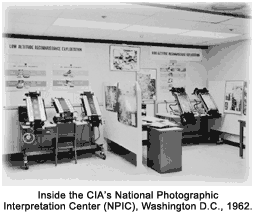 Looking back at the Cuban Missile Crisis, it is clear that SIGINT, combined with such other types of intelligence as photography and human sources, had pinpointed Cuba as a serious threat to the United States. During the crisis, the intelligence community gave to the president all the information he needed to successfully extricate the nation from its most dire predicament since World War II.
Looking back at the Cuban Missile Crisis, it is clear that SIGINT, combined with such other types of intelligence as photography and human sources, had pinpointed Cuba as a serious threat to the United States. During the crisis, the intelligence community gave to the president all the information he needed to successfully extricate the nation from its most dire predicament since World War II.